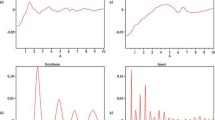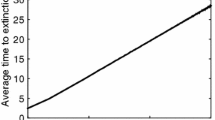Abstract
Among-individual variation in vital parameters such as birth and death rates that is unrelated to age, stage, sex, or environmental fluctuations is referred to as demographic heterogeneity. This kind of heterogeneity is prevalent in ecological populations, but is almost always left out of models. Demographic heterogeneity has been shown to affect demographic stochasticity in small populations and to increase growth rates for density-independent populations. The latter is due to “cohort selection,” where the most frail individuals die out first, lowering the cohort’s average mortality as it ages. The importance of cohort selection to population dynamics has only recently been recognized. We use a continuous-time model with density dependence, based on the logistic equation, to study the effects of demographic heterogeneity in mortality and reproduction. Reproductive heterogeneity is introduced in three ways: parent fertility, offspring viability, and parent–offspring correlation. We find that both the low-density growth rate and the equilibrium population size increase as the magnitude of mortality heterogeneity increases or as parent–offspring phenotypic correlation increases. Population dynamics are affected by complex interactions among the different types of heterogeneity, and trade-off scenarios are examined which can sometimes reverse the effect of increased heterogeneity. We show that there are a number of different homogeneous approximations to heterogeneous models, but all fail to capture important parts of the dynamics of the full model.




Similar content being viewed by others
References
Bessa-Gomes C, Legendre S, Clobert J (2004) Allee effects, mating systems and the extinction risk in populations with two sexes. Ecol Lett 7(9):802–812. doi:10.1111/j.1461-0248.2004.00632.x
Bollinger EK, Gavin TA (2004) Responses of nesting bobolinks (Dolichonyx oryzivorus) to habitat edges. Auk 121(3):767–776. doi:10.1642/0004-8038(2004)121[0767:RONBDO]2.0.CO%3B2
Boulding E, Van Alstyne K (1993) Mechanisms of differential survival and growth of two species of Littorina on wave-exposed and on protected shores. J Exp Mar Biol Ecol 169(2):139–166. doi:10.1016/0022-0981(93)90191-P
Brown GP, Shine R (2009) Beyond size-number trade-offs: clutch size as a maternal effect. Philos Trans R Soc Lond, B Biol Sci 364(1520):1097–1106. doi:10.1098/rstb.2008.0247
Carey JR, Liedo P, Orozco D (1992) Slowing of mortality-rates at older ages in large medfly cohorts. Science 258(5081):457–461. doi:10.1126/science.1411540
Casellas J, Noguera JL, Varona L, Sánchez A, Arqué M, Piedrafita J (2004) Viability of Iberian × Meishan F2 newborn pigs. II. Survival analysis up to weaning. J Anim Sci 82(7):1925–1930. http://jas.fass.org/cgi/content/abstract/82/7/1925
Caswell H, Weeks DE (1986) Two-sex models: Chaos, extinction, and other dynamic consequences of sex. The American Naturalist 128(5):707–735. http://www.jstor.org/stable/2461952
Cohen JE (1986) An uncertainty principle in demography and the unisex issue. Am Stat 40(1):32–39. http://www.jstor.org/stable/2683114
Conner MM, White GC (1999) Effects of individual heterogeneity in estimating the persistence of small populations. Natural Resource Modeling 12:109–127. doi:10.1111/j.1939-7445.1999.tb00005.x
Dennis B, Desharnais RA, Cushing JM, Henson SM, Costantino RF (2001) Estimating chaos and complex dynamics in an insect population. Ecol Monogr 71(2):277–303. doi:10.1890/0012-9615(2001)071[0277:ECACDI]2.0.CO%3B2
Ducrocq V, Besbes B, Protais M (2000) Genetic improvement of laying hens viability using survival analysis. Genetics, Selection, Evolution 32(1):23–40. doi:10.1051/gse%3A2000104
Fox GA (2005) Extinction risk of heterogeneous populations. Ecology 86(5):1191–1198. doi:10.1890/04-0594
Fox CW, Czesak ME (2000) Evolutionary ecology of progeny size in arthropods. Annu Rev Entomol 45:341–369. doi:10.1146/annurev.ento.45.1.341
Fox GA, Kendall BE (2002) Demographic stochasticity and the variance reduction effect. Ecology 83(7):1928–1934. doi:10.2307/3071775
Fox GA, Kendall BE, Fitzpatrick JW, Woolfenden GE (2006) Consequences of heterogeneity in survival probability in a population of Florida scrub-jays. J Anim Ecol 75(4):921–927. doi:10.1111/j.1365-2656.2006.01110.x
Franklin AB, Anderson DR, Gutiérrez RJ, Burnham KP (2000) Climate, habitat quality, and fitness in Northern Spotted Owl populations in northwestern California. Ecol Monogr 70(4):539–590. doi:10.1890/0012-9615%282000%29070%5B0539%3ACHQAFI%5D2.0.CO%3B2
Gates JE, Gysel LW (1978) Avian nest dispersion and fledging success in field-forest ecotones. Ecology 59:871–883. doi:10.2307/1938540
Gerdes LU, Jeune B, Ranberg KA, Nybo H, Vaupel JW (2000) Estimation of apolipoprotein E genotype-specific relative mortality risks from the distribution of genotypes in centenarians and middle-aged men: Apolipoprotein E gene is a “frailty gene,” not a “longevity gene”. Genet Epidemiol 19(3):202–210. doi:10.1002/1098-2272%28200010%2919%3A3%3C202%3AAID-GEPI2%3E3.0.CO%3B2-Q
Girondot M, Pieau C (1993) Effects of sexual differences of age at maturity and survival on population sex ratio. Evol Ecol 7:645–650. doi:10.1007/BF01237827
Isberg SR, Thomson PC, Nicholas FW (2006) Quantitative analysis of production traits in saltwater crocodiles (Crocodylus porosus): III. Juvenile survival. J Anim Breed Genet 123(1):44–47. doi:10.1111/j.1439-0388.2006.00557.x
Jenouvrier S, Caswell H, Barbraud C, Weimerskirch H (2010) Mating behavior, population growth, and the operational sex ratio: a periodic two-sex model approach. Am Nat 175(6):739–752. doi:10.1086/652436
Johnstone RA (2004) Begging and sibling competition: how should offspring respond to their rivals? Am Nat 163(3):388–406. doi:10.1086/375541
Jones LE, Ellner SP (2007) Effects of rapid prey evolution on predatorŰprey cycles. J Math Biol 55:541–573. doi:10.1007/s00285-007-0094-6
Kendall BE, Fox GA (2002) Variation among individuals and reduced demographic stochasticity. Conserv Biol 16(1):109–116, doi:10.1046/j.1523-1739.2002.00036.x
Kendall BE, Fox GA (2003) Unstructured individual variation and demographic stochasticity. Conserv Biol 17(4):1170–1172. doi:10.1046/j.1523-1739.2003.02411.x
Kendall B, Fox G, Fujiwara M, Nogeire T (2011) Demographic heterogeneity, cohort selection, and population growth. Ecology (in press)
Landis RM, Gurevitch J, Fox GA, Fang W, Taub DR (2005) Variation in recruitment and early demography in Pinis ridida following crown fire in the pine barrens of Long Island, New York. J Ecol 93(3):607–617. doi:10.1111/j.1365-2745.2005.00996.x
Lindström J (1999) Early development and fitness in birds and mammals. Trends Ecol Evol 14(9):343–348. doi:10.1016/S0169-5347%2899%2901639-0
Lloyd-Smith JO, Schreiber SJ, Kopp PE (2005) Superspreading and the effect of individual variation on disease emergence. Nature 438(7066):355–359. doi:10.1038/nature04153
Lynch M, Walsh B (1998) Genetics and analysis of quantitative traits. Sinauer Associates, Sunderland
Manolis JC, Andersen DE, Cuthbert FJ (2002) Edge effect on nesting success of ground nesting birds near regenerating clearcuts in a forest-dominated landscape. Auk 119(4):955–970. doi:10.1642/0004-8038%282002%29119%5B0955%3AEEONSO%5D2.0.CO%3B2
Manser MB, Avey G (2000) The effect of pup vocalisations on food allocation in a cooperative mammal, the meerkat (Suricata suricatta). Behav Ecol Sociobiol 48(6):429–437. doi:10.1007/s002650000248
Manton KG, Stallard E, Vaupel JW (1981) Methods for comparing the mortality experience of heterogeneous populations. Demography 18(3):389–410. http://www.jstor.org/stable/2061005
Marshall DJ, Keough MJ (2007) The evolutionary ecology of offspring size in marine invertebrates. Adv Mar Biol 53:1–60. doi:10.1016/S0065-2881%2807%2953001-4
McGinley MA, Temme DH, Geber MA (1987) Parental investment in offspring in variable environments: theoretical and empirical considerations. Am Nat 130(3):370–398. http://www.jstor.org/stable/2461891
Melbourne B, Hastings A (2008) Extinction risk depends strongly on factors contributing to stochasticity. Nature 454(7200):100–103. doi:10.1038/nature06922
Menge BA, Berlow EL, Blanchette CA (1994) The keystone species concept—variation in interaction strength in a rocky intertidal habitat. Ecol Monogr 64(3):249–286. doi:10.2307/2937163
Robert A, Sarrazin F, Couvet D (2003) Variation among individuals, demographic stochasticity, and extinction: response to Kendall and Fox. Conserv Biol 17(4):1166–1169. doi:10.1046/j.1523-1739.2003.02259.x
Smith CC, Fretwell SD (1974) The optimal balance between size and number of offspring. Am Nat 108(962):499–506. http://www.jstor.org/stable/2459681
Uchmański J (2000) Individual variability and population regulation: an individual-based model. Oikos 90(3):539–548. doi:10.1034/j.1600-0706.2000.900312.x
Vaupel JW, Yashin AI (1983) The deviant dynamics of death in heterogeneous populations. Research Reports RR-83-1, International Institute for Applied Systems Analysis, Laxenburg, Austria
Vaupel JW, Yashin AI (1985) Heterogeneity’s ruses: some surprising effects of selection on population dynamics. Am Stat 39(3):176–185. http://www.jstor.org/stable/2683925
Vaupel JW, Carey JR (1993) Compositional interpretations of medfly mortality. Science 260(5114):1666–1667. doi:10.1126/science.8503016
Venable DL (1992) Size-number trade-offs and the variation of seed size with plant resource status. Am Nat 140(2):287–304. http://www.jstor.org/stable/2462610
Veran S, Beissinger SR (2009) Demographic origins of skewed operational and adult sex ratios: perturbation analyses of two-sex models. Ecol Lett 12(2):129–143. doi:10.1111/j.1461-0248.2008.01268.x
Vindenes Y, Engen S, Sæther BE (2008) Individual heterogeneity in vital parameters and demographic stochasticity. Am Nat 171(4):455–467. doi:10.1086/528965
von Holst D, Hutzelmeyer H, Kaetzke P, Khaschei M, Rödel HG, Schrutka H (2002) Social rank, fecundity and lifetime reproductive success in wild european rabbits (oryctolagus cuniculus). Behav Ecol Sociobiol 51(3):245–254. doi:10.1007/s00265-001-0427-1
Winter M, Johnson DH, Faaborg J (2000) Evidence for edge effects on multiple levels in tallgrass prairie. Condor 102(2):256–266. http://www.jstor.org/stable/1369636
Yashin AI, Iachine IA, Harris JR (1999) Half of the variation in susceptibility to mortality is genetic: findings from Swedish twin survival data. Behav Genet 29(1):11–19. doi:10.1023/A%3A1021481620934
Acknowledgement
We thank two anonymous reviewers for helpful comments which improved the manuscript. This material is based upon work supported by the National Science Foundation under grant no. 615024.
Author information
Authors and Affiliations
Corresponding author
Appendix: Population structure
Appendix: Population structure
We solve \(\frac{\rm d}{{\rm d}t}n(t)=0\) and \(\frac{\rm d}{{\rm d}t}q(t)=0\) for \(u=\frac{q}{n}\) and arrive at two quadratic equations, one for n(t) = n * and the other for n(t) = 0. The equilibrium structure, u *, is the solution to the equation au 2 + bu + c = 0 whose coefficients are
and
If a ≠ 0, then the equation is quadratic, and there are two candidate solutions. When \(f>-h\frac{v+\sigma_\delta}{1+\sigma_\delta v}\), u * is given by the ‘+’ root, and alternatively it is given by the ‘−’ root. When a = 0 the equation is linear, and u * = − c/b.
If \(v>-\frac{hf+\sigma_\delta}{1+hf\sigma_\delta}\), then phenotype two dominates the equilibrium population (u * > 0), and if \(v<-\frac{hf+\sigma_\delta}{1+hf\sigma_\delta}\), then phenotype one dominates the equilibrium population (u * > 0).
The structure along the eigenvector out of the origin, u o, is the solution to the equation au 2 + bu + c = 0 whose coefficients are
and
Similar to the equilibrium structure, when the coefficient a > 0, then we take the “+” root, and when a < 0, then we take the “−” root.
Rights and permissions
About this article
Cite this article
Stover, J.P., Kendall, B.E. & Fox, G.A. Demographic heterogeneity impacts density-dependent population dynamics. Theor Ecol 5, 297–309 (2012). https://doi.org/10.1007/s12080-011-0129-x
Received:
Accepted:
Published:
Issue Date:
DOI: https://doi.org/10.1007/s12080-011-0129-x




